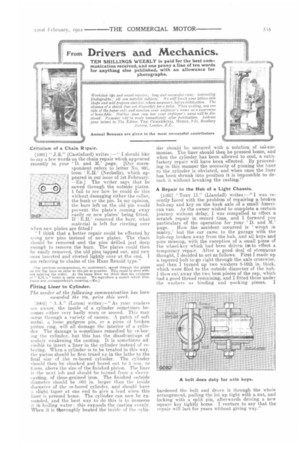Drivers and Mechanics.
Page 27

If you've noticed an error in this article please click here to report it so we can fix it.
TEN SHILLINGS WEEKLY is paid for the best communication received, and one penny a line of ten words for anything else published, with an allowance for photographs.
Criticism of a Chain Rzvair. [1001] " J.S." (Castleford) writes:—" 1 should like: to say a few words on the chain repair which appeared recently in your ID. and M.' page. [Our correspondent refers to letter No. 991, trona ' E.H.' (Nechells), which appeared in our issue of 1st February. —En.] The writer says that he sawed through the outside plates. I fail to see how he could do this without damaging either the roller, the bush or the pin. In my opinion, the burr left on the old pin would prevent the plate's coming away easily or new plates' being fitted. If E.H.' removed the burr, what material is left for riveting over when new plates are fitted? " I think that a better repair could be effected by using new pins instead of new plates. The chain should be removed and the pins drilled just deep enough to remove the burr. The plates could then be easily removed, the old pins tapped out, and new ones inserted and riveted lightly over at the end. I am referring to chains of the Hans Renold type."
=LE [
0107 Our previous correspondent, we understand, sawed through the plates on the Hat faces as close to the pin as possible. This could he done without injuring the roller. At the same time we think that the criticism 01 1. all's' letter Is quite sound. We reproduce a sketch which illustrates our correspondent's meaning.—En.]
Fitting Liner to Cylinder.
The sender of the following communication has been awarded the ms, prize this week. [100] " A.A." (Luton) writes:—" As your readers :ire aware, the inside of a cylinder sometimes becomes either very badly worn or scored. This may occur through a variety of causes. A patch of soft, metal, a loose gudgeon pin, or a piece of broken piston ring, will all damage the interior of a cylinder. re-boring the cylinder, but this has the disadvantage of unduly weakening the casting. It is sometimes advisible to insert a liner in the cylinder instead of reboring. When a cylinder is to be treated in this way, the piston should be first trued up in the lathe to the final size of the re-bored cylinder. The cylinder should then he chucked and bored out to 5 mm. or 6 mm, above the size of the finished piston. The liner is the next job and should be turned from a sleevecasting, of close-grained iron. The finished outside diameter should be .003 in. larger than the inside diameter of the re-bored cylinder, and should have a slight taper at one end to give a lead when this liner is pressed home. The cylinder can now be exoanded, and the best way to do this is to immerse it in boiling water: this expands the casting evenly. When it is thoroughly heated the inside of the eylin der should be smeared with a solution of sal-ammoniac. The liner should then be pressed home, and when the cylinder has been allowed to cool, a satisfactory repair will have been effected. By proceeding in this manner the necessity of pinning the liner to the cylinder is obviated, and when once the liner has been shrunk into position it is impossible to detach it without breaking the casting."
A Repair to the Hub of a Light Chassis. [1003] " Tony II." (Llandaff) writes :—" I was recently faced with the problem of repairing a broken hub-cap and key on the back axle of a small American van. As the owner wished to complete a certain journey without delay, I was compelled to effect a scratch repair in record time, and 1 forward you particulars of the operation for your D. and 141.' page. How the accident occurred is wropt in mistry,' but the car came to the garage with the hub-cap broken away from the hub, and all keys and pins missing, with the exception of a small piece of the wheel-key which had been driven inato effect a temporary repair. After a good deal of strenuous thought, I decided to act as follows. First I made up a tapered bolt to go right through the axle crosswise, and then I turned up two washers 5-16th in. thick, which were filed to the outside diameter of the hub. I then cut away the two best pieces of the cap, which had a good thread remaining, and I fitted these under the washers as binding and packing pieces. I hardened the bolt and drove it through the whole arrangement, pulling the lot up tight with a. nut, and locking with a split pin, afterwards driving a new square key tightly home. I venture to say that the repair will last for years without giving way."




























